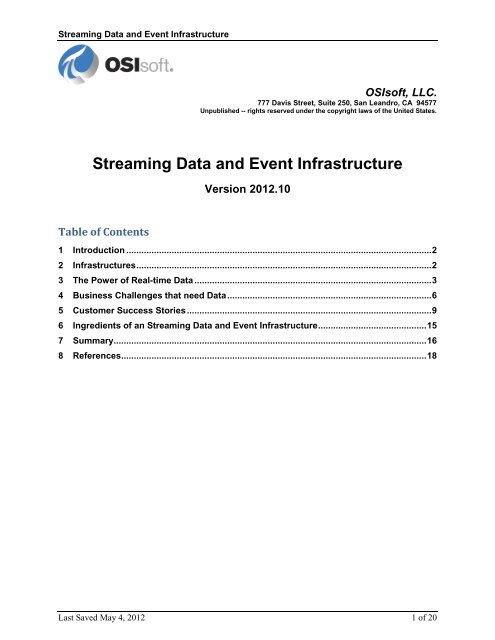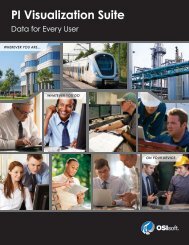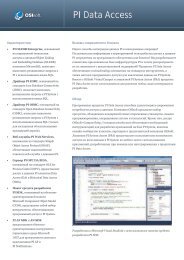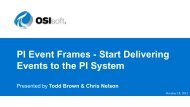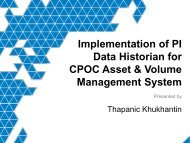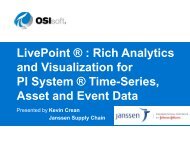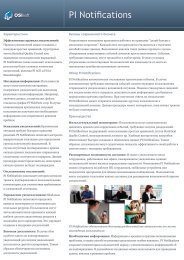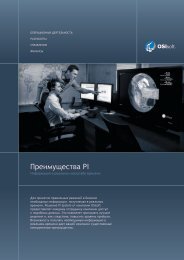Streaming Data and Event Infrastructure - OSIsoft
Streaming Data and Event Infrastructure - OSIsoft
Streaming Data and Event Infrastructure - OSIsoft
Create successful ePaper yourself
Turn your PDF publications into a flip-book with our unique Google optimized e-Paper software.
<strong>Streaming</strong> <strong>Data</strong> <strong>and</strong> <strong>Event</strong> <strong>Infrastructure</strong><br />
<strong>OSIsoft</strong>, LLC.<br />
777 Davis Street, Suite 250, San Le<strong>and</strong>ro, CA 94577<br />
Unpublished -- rights reserved under the copyright laws of the United States.<br />
<strong>Streaming</strong> <strong>Data</strong> <strong>and</strong> <strong>Event</strong> <strong>Infrastructure</strong><br />
Table of Contents<br />
Version 2012.10<br />
1 Introduction ......................................................................................................................... 2<br />
2 <strong>Infrastructure</strong>s ..................................................................................................................... 2<br />
3 The Power of Real-time <strong>Data</strong> .............................................................................................. 3<br />
4 Business Challenges that need <strong>Data</strong> ................................................................................. 6<br />
5 Customer Success Stories ................................................................................................. 9<br />
6 Ingredients of an <strong>Streaming</strong> <strong>Data</strong> <strong>and</strong> <strong>Event</strong> <strong>Infrastructure</strong> ........................................... 15<br />
7 Summary ............................................................................................................................ 16<br />
8 References ......................................................................................................................... 18<br />
Last Saved May 4, 2012 1 of 20
<strong>Streaming</strong> <strong>Data</strong> <strong>and</strong> <strong>Event</strong> <strong>Infrastructure</strong><br />
1 Introduction<br />
Companies today are in need of a “<strong>Streaming</strong> <strong>Data</strong> <strong>and</strong> <strong>Event</strong> <strong>Infrastructure</strong>” to enable their<br />
business to respond quickly <strong>and</strong> decisively to a wide range of issues.<br />
The maxim ‘what gets measured gets done’ still applies to any organization that intends to<br />
drive its operations to a higher level. However, building a responsive data driven business<br />
during times of great change <strong>and</strong> uncertainty will require an updated perspective, new tools<br />
<strong>and</strong> skill sets to make access to data part of the organizational culture. Companies must also<br />
empower employees to take action on the data. This whitepaper describes a “<strong>Streaming</strong> <strong>Data</strong><br />
<strong>and</strong> <strong>Event</strong> <strong>Infrastructure</strong>” required by business today in order to improve performance.<br />
This white paper will first look at what we mean by infrastructure <strong>and</strong> how it has been a key<br />
enabler to business. The “Power of <strong>Data</strong>” to achieve situational awareness, empowers<br />
continuous improvement <strong>and</strong> provides for sustainability <strong>and</strong> innovation. Today’s key business<br />
challenges <strong>and</strong> how data is used to address them will be discussed. Customer examples of<br />
using an infrastructure approach to manage real- time data <strong>and</strong> the resultant success will be<br />
given. Lastly the components of a “<strong>Streaming</strong> <strong>Data</strong> <strong>and</strong> <strong>Event</strong> <strong>Infrastructure</strong>” are highlighted.<br />
2 <strong>Infrastructure</strong>s<br />
<strong>Infrastructure</strong>s have a long history of making great change in business <strong>and</strong> society. The<br />
Railroad was an infrastructure that opened the West, allowed cities to grow up along it or fade<br />
away if they did not or could not leverage. In the 1950’s President Eisenhower supported the<br />
Interstate highway system that made our society more mobile. The municipal water systems<br />
gave rise to more modern <strong>and</strong> cleaner cities, the power grid enabled electronic society of<br />
appliances for all aspects of our lives. The Internet has connected the globe, changed the face<br />
of commerce, <strong>and</strong> brought information to the masses. Today’s wireless networks have truly<br />
mobilized our workforce giving instant access to data, information <strong>and</strong> personal resources.<br />
<strong>OSIsoft</strong> believes in the power of an infrastructure as enabling technologies. Their principles<br />
have invested in partnering with the city of San Le<strong>and</strong>ro where it is headquartered to provide<br />
access to high speed, low cost 10Gbps internet as an enabling technology for business<br />
development in the city for the Lit San Le<strong>and</strong>ro project.<br />
A single application or requirement need could not have justified any of these great<br />
infrastructure projects however the results have been paid back many times over their<br />
investment.<br />
However, we often see businesses approach the access to operation data needs as a contained,<br />
singular solution that must be justified on isolated business requirements. This results in point<br />
solutions that often isolate data, limit access <strong>and</strong> fail to meet changing business requirements.<br />
Today’s businesses are required to operate fast <strong>and</strong> globally, often making decision on limited<br />
data, e.g which plant has capacity, where is inventory, which assets have low reliability, which<br />
Last Saved May 4, 2012 2 of 20
<strong>Streaming</strong> <strong>Data</strong> <strong>and</strong> <strong>Event</strong> <strong>Infrastructure</strong><br />
products are costly to make, <strong>and</strong> the list goes on. How much better would these decisions be if<br />
the people had all the data, everywhere <strong>and</strong> anytime? Often we do not know what we need<br />
until the problem arises <strong>and</strong> then it is too late to question if we collect the data. Our world<br />
today is instrumented all over. Sensors were once applied to only the most costly equipment<br />
however today we are now able to obtain measurements from a large range of devices <strong>and</strong><br />
systems economically.<br />
<strong>OSIsoft</strong> proposes <strong>and</strong> has since 1983 that a business today should collect all the data all the<br />
time at the original data fidelity because aggregation <strong>and</strong> averages can mask behavior or<br />
transient upsets. <strong>Streaming</strong> data systems are able to collect <strong>and</strong> store this data without<br />
excessive costs within a real-time infrastructure for data streams <strong>and</strong> events. The building of<br />
such an infrastructure can provide companies a competitive advantage when they have data<br />
required to focus on innovation <strong>and</strong> sustainability while maintaining situational awareness <strong>and</strong><br />
continuous improvement.<br />
3 The Power of Real-time <strong>Data</strong><br />
“Power of <strong>Data</strong>” which is a topic that is universal, transcends all frontiers, transcends all<br />
industries, transcend all activities <strong>and</strong> is making it in our life, in a big way, called “Big <strong>Data</strong>”. The<br />
topic of data is now ubiquitous, a daily conversation in all spheres of business, technology <strong>and</strong><br />
society. The etymology of data, the verb “dare” in latin, refers to what we “are given” to<br />
analyze, underst<strong>and</strong>, <strong>and</strong> solve problems.<br />
A recent New York Times article “Age of Big <strong>Data</strong>” proposes that we are in “the age of big data.”<br />
Big data, says the article is “shorth<strong>and</strong> for advancing trends in technology that open the door to<br />
a new approach to underst<strong>and</strong>ing the world <strong>and</strong> making decisions.” The article quotes IDC, a<br />
technology research firm as estimating that data, by volume, is growing at 50 percent each<br />
year. There are now countless digital sensors worldwide in industrial equipment, automobiles,<br />
electrical meters <strong>and</strong> shipping crates. They can measure <strong>and</strong> communicate location, movement,<br />
vibration, temperature, humidity, even chemical changes in the air according to the article.<br />
Communicating sensors with computer intelligence gives rise to improved information access<br />
so that decisions will increasingly be based on data <strong>and</strong> analysis rather than on experience <strong>and</strong><br />
intuition.<br />
In the last decade we often used catastrophic event metaphors such as <strong>Data</strong> Eruption, <strong>Data</strong><br />
flood, <strong>Data</strong> Tsunami, <strong>Data</strong> deluge, to describe how overwhelming data had become. Some<br />
have referred to <strong>Data</strong> Overload, <strong>Data</strong> Obesity, Noise, Distraction or the need to go on an<br />
information diet to describe the challenges of dealing with large quantities of data.<br />
As the information age, described as “the third wave” by the futurist Alvin Toffler, settled in <strong>and</strong><br />
computing <strong>and</strong> networking were commoditized, we started to realize that data, lots of data<br />
could be turned into an opportunity <strong>and</strong> started using the term “Big <strong>Data</strong>” to describe data<br />
quantity that exceeds the processing capacity of conventional database systems.<br />
Last Saved May 4, 2012 3 of 20
<strong>Streaming</strong> <strong>Data</strong> <strong>and</strong> <strong>Event</strong> <strong>Infrastructure</strong><br />
<strong>OSIsoft</strong> customers <strong>and</strong> PI System users, have been dealing with this data reality for many years.<br />
They know that “data” is an essential element of better decision making, the foundation of<br />
operational excellence, innovation <strong>and</strong> sustainability <strong>and</strong> is essential for maintaining situational<br />
awareness <strong>and</strong> readiness.<br />
We estimate that PI System users, taken collectively manage over 235 MM data streams at this<br />
moment <strong>and</strong> customers have been historizing their PI System data for over 20 years. The<br />
number of data streams has exploded in recent years <strong>and</strong> will continue to grow exponentially<br />
driven by the internet of things. We estimate at 300 MM the number of active data streams<br />
that the PI Systems will be h<strong>and</strong>ling by 2012 year end.<br />
Timely, easy <strong>and</strong> enterprise wide access to streaming data <strong>and</strong> events is a requirement of the<br />
modern enterprise <strong>and</strong> a very tangible manifestation of the “Big <strong>Data</strong>” phenomenon which is<br />
receiving so much attention lately. We are moving into a data, measurement <strong>and</strong> insight based<br />
world where experience, knowledge <strong>and</strong> data are combined to drive value creation, drive<br />
latency out of decision making underst<strong>and</strong> change <strong>and</strong> increase predictability of targeted<br />
outcomes.<br />
Today, entire businesses are built around data <strong>and</strong> these businesses thrive <strong>and</strong> support<br />
economic <strong>and</strong> social development. One of the best examples we experience every day is the<br />
management of the electrical grid which is largely dependent on streaming data <strong>and</strong> events, in<br />
very large quantity, to achieve the availably <strong>and</strong> the reliability of electrical energy supply. That<br />
data that supports these businesses has to be as reliable <strong>and</strong> available as the service they<br />
provide, in this case electricity. This is one of the reasons the industry is hiring the PI System<br />
<strong>and</strong> <strong>OSIsoft</strong> to do this job.<br />
Large data sets like the ones found in PI systems have notable characteristics:<br />
VOLUME - The volume of data is large – a function of how many sensors, their sampling<br />
rate <strong>and</strong> how long data has been collecting;<br />
VELOCITY – it varies greatly, can be very high <strong>and</strong> will be getting higher; data may arrive<br />
synchronously or asynchronously; latency can be negligible or significant <strong>and</strong> important.<br />
DIVERSITY - Wide diversity of data types come into play - analog input, digital Input,<br />
conventional <strong>and</strong> intelligent sensors, external data sources like weather, prices, non<br />
persisting business data, etc.<br />
STRUCTURE - <strong>Data</strong> payloads from intelligent sensors carry the data <strong>and</strong> information<br />
about the data: its structure, its lineage, <strong>and</strong> its state. Systems must recognize <strong>and</strong><br />
leverage this ‘meta’ data creating <strong>and</strong> updating structure on the go.<br />
ANALYTICS - Pre <strong>and</strong> post processing driving real time analytics are the norm <strong>and</strong> used<br />
on a large scale at high speed <strong>and</strong> are an essential part of the maintaining deep<br />
situational awareness.<br />
What is the power of all that data?<br />
This power of data is knowledge preservation.<br />
This power of data is to enable assets to speak to us?<br />
Last Saved May 4, 2012 4 of 20
<strong>Streaming</strong> <strong>Data</strong> <strong>and</strong> <strong>Event</strong> <strong>Infrastructure</strong><br />
The power of data allows important signals to manifest themselves through trends <strong>and</strong><br />
analysis rules;<br />
This power of data drives predictability;<br />
This power of data helps figuring out cause to effect relationships as in condition based<br />
maintenance, RCM;<br />
This power of data is to measures outcomes or impacts of our decisions;<br />
The power of data augments our ability to decide, resolve issues, innovate <strong>and</strong> gain<br />
insight.<br />
The Power of <strong>Data</strong> is universal, available to everyone, augmented by collaboration, <strong>and</strong>, is<br />
moving us into an era of rapid innovation <strong>and</strong> progress.<br />
So, is Big <strong>Data</strong> hype or reality? Real Big <strong>Data</strong> requires new skills <strong>and</strong> new roles such as data<br />
analysts, data scientists, data experts, etc. But, we see that the interest for these new roles is<br />
still lagging the “Big <strong>Data</strong>” phenomenon. Fortunately, <strong>OSIsoft</strong> customers have been data driven<br />
for many years <strong>and</strong> have a head start in the practice of the data analysis or data science. What<br />
is this head start worth? Dr. Brynjolfsson <strong>and</strong> his colleagues at MIT reported in one of the first<br />
research works conducted on data driven decisions that this technology can boost productivity<br />
<strong>and</strong> output by 5 to 6 % <strong>and</strong> drive the adoption of information technologies enterprise wide.<br />
With the power of data at h<strong>and</strong>, we are entering an era where data driven decision making will<br />
become not only a common skill but a skill critical for success, both for people <strong>and</strong><br />
organizations.<br />
Situational Awareness<br />
The availability of data allows a business to maintain situational awareness, to know where<br />
your business is <strong>and</strong> the external forces that affect it. Whether a business is looking for its<br />
production numbers, quality, emission, productivity, resource consumption or commodity<br />
pricing <strong>and</strong> market fluctuations or customer requirements the data is available. An exact<br />
picture of where you st<strong>and</strong> <strong>and</strong> comparisons to similar situations is available for analysis <strong>and</strong><br />
insight.<br />
With this much data, obtaining it by exception via notifications as events occur has become<br />
critical. The data is available for multiuser access <strong>and</strong> collaboration for better solution<br />
resolution. Detail analyses for planning <strong>and</strong> what if studies are now supported with actual data.<br />
The data is easily visualized <strong>and</strong> placed in context lowering the cost of curiosity <strong>and</strong> managing<br />
the risks <strong>and</strong> opportunities of the business.<br />
Continuous Improvement<br />
Continuous improvement requires knowledge of the current <strong>and</strong> past situations in order to<br />
identify the root cause of the problem. The availability of current data as well as historical data<br />
Last Saved May 4, 2012 5 of 20
<strong>Streaming</strong> <strong>Data</strong> <strong>and</strong> <strong>Event</strong> <strong>Infrastructure</strong><br />
provides the context to identify problems <strong>and</strong> propose solutions for continuous improvement.<br />
One must also have the ability to implement six sigma procedures of measure, analyze, control<br />
<strong>and</strong> optimize. Visualization tools that provide methods to performance benchmark, display<br />
KPIs <strong>and</strong> dashboards are key to measuring improvement <strong>and</strong> making data available to everyone<br />
to fuel a culture of improvement. Tools for visualization also allow the user to discover new<br />
patterns, insights <strong>and</strong> are the fuel for innovation. The socialization of data allows for<br />
collaboration <strong>and</strong> problem solving. <strong>Data</strong> must be provided in context with easy tools to lower<br />
the cost of curiosity <strong>and</strong> cross specialty data access.<br />
Foundation for Sustainability <strong>and</strong> Innovation<br />
From its “green team” origins, corporate sustainability has found its way into the executive<br />
suite <strong>and</strong> corporate boardroom. Many organizations now have a chief sustainability officer, <strong>and</strong><br />
some of these same companies routinely issue reports on their progress toward sustainability.<br />
However, largely missing from the sustainability calculus is a way to move into the mainstream<br />
of day-to-day workplace decisions. For sustainability to reach the next level, operations staff<br />
who make resource decisions need feedback <strong>and</strong> visibility on the results of their actions, <strong>and</strong><br />
senior executives need a way to gauge performance so they can reward improvements <strong>and</strong><br />
troubleshoot lingering problems.<br />
Sustainability is a platform for managing business in an efficient <strong>and</strong> holistic manner. It provides<br />
resource <strong>and</strong> production decision-makers with tools <strong>and</strong> support to make better decisions.<br />
Key benefits of a focus on sustainability are resource, water <strong>and</strong> energy efficiency, pollutions<br />
abatement <strong>and</strong> asset optimization. All of these are empowered with the access to data.<br />
Today sustainability data is collected <strong>and</strong> available with large time delays. Tomorrow we have<br />
the potential of controlling our business to sustainability goals with real-time data allow actions<br />
to take place to improve situations rather than just report. Records of sustainability data will<br />
take on an importance similar to financial data.<br />
The best innovation comes when people ask what if, why not, how we can in a process that<br />
encourages action. All of these questions are helped with the access to data that allows for the<br />
modeling, scenario testing <strong>and</strong> results validation. Innovation is inspired by seeing patterns in<br />
data <strong>and</strong> studying relationships between data. When the access to data is lowered <strong>and</strong> data is<br />
available across disciplines new ideas can be proposed, investigated <strong>and</strong> proven.<br />
4 Business Challenges that need <strong>Data</strong><br />
Today’s business faces common challenges no matter what the industry is. We reviewed 73<br />
annual reports from companies in Pulp & Paper, Oil <strong>and</strong> Gas, Utilities, Pharmaceuticals <strong>and</strong> Life<br />
Sciences, Metals <strong>and</strong> Mining <strong>and</strong> Chemicals <strong>and</strong> Petrochemicals compiling what are identified<br />
as business challenges. This list shows the clear advantage of infrastructure over a single project<br />
based solution due to the breadth of the issues.<br />
Last Saved May 4, 2012 6 of 20
<strong>Streaming</strong> <strong>Data</strong> <strong>and</strong> <strong>Event</strong> <strong>Infrastructure</strong><br />
Cost Management<br />
Business must control their capital <strong>and</strong> variable costs. This means how the most can be<br />
achieved from available assets <strong>and</strong> prolonging the lifetime of equipment <strong>and</strong> facilities. What<br />
facilities are operating better <strong>and</strong> which ones have room for improvement <strong>and</strong> where <strong>and</strong> when<br />
to invest in new facilities <strong>and</strong> equipment. All of these require access to data <strong>and</strong> operational<br />
statistics. There are also the large variable costs of energy <strong>and</strong> water <strong>and</strong> how the process of<br />
using both can be controlled <strong>and</strong> optimized. The use of raw materials <strong>and</strong> the recycle <strong>and</strong><br />
repurpose of waste material for financial gain require process optimization <strong>and</strong> innovative<br />
solutions.<br />
Businesses continue to look to acquire <strong>and</strong> divest as required by the changing marketplace <strong>and</strong><br />
global needs of operations. The data associated with these facilities must be easily integrated<br />
into the corporation or separated. This requires a flexible data infrastructure that easily<br />
integrates with existing systems.<br />
Sustainability<br />
Today’s corporation’s actions are more visible <strong>and</strong> they are being held to a new st<strong>and</strong>ard of<br />
corporate citizenship by customers <strong>and</strong> governments. This means compliance with regulations<br />
for health, safety <strong>and</strong> the environment. <strong>Data</strong> supporting the corporate result is required to<br />
become more visible <strong>and</strong> timely. In some industries the carbon footprint must be associated<br />
with finished products <strong>and</strong> customers are making buying decisions based on the data.<br />
Sustainability requires operations to save energy, optimize raw material resources <strong>and</strong> manage<br />
water use while minimizing waste production. Communication of corporate status on<br />
sustainability is becoming a more frequent activity <strong>and</strong> needs will be changing to operate for<br />
sustainability rather than just reporting after the fact. To move to sustainable operations data<br />
will be required in real-time to allow for actions to maintain sustainability objectives.<br />
Manufacturing <strong>and</strong> Operations<br />
Manufacturing is required to produce a high quality product at the lowest cost while complying<br />
with environment <strong>and</strong> legal requirements. There is the need to plan production across the<br />
whole manufacturing space while operating an individual facility at its optimum conditions.<br />
This requires accurate, timely information to be shared across facilities while optimizing <strong>and</strong><br />
responding to operational dem<strong>and</strong>s within a facility. <strong>Data</strong> must be readily available <strong>and</strong> shared.<br />
Assets must be controlled, maintained <strong>and</strong> serviced to meet the dem<strong>and</strong>s of production while<br />
assuring the lifetime of the asset.<br />
There is the need to cost effectively increase production will maintaining operational integrity.<br />
Often new dem<strong>and</strong>s in flexible manufacturing must be met to respond to changing product <strong>and</strong><br />
global market dem<strong>and</strong>s.<br />
Last Saved May 4, 2012 7 of 20
<strong>Streaming</strong> <strong>Data</strong> <strong>and</strong> <strong>Event</strong> <strong>Infrastructure</strong><br />
To meet these dem<strong>and</strong>s rigorous benchmarking, upgrading <strong>and</strong> debottlenecking of facilities is<br />
required, all of which require operational data for engineering studies. The true cost of<br />
production for products must be known.<br />
Enhanced production, operation <strong>and</strong> decision making for continuous improvement require<br />
access to data. Performance improvements <strong>and</strong> development is made with continuous<br />
feedback, attention to global st<strong>and</strong>ards in operation <strong>and</strong> implementing state of the art<br />
manufacturing for quicker response to market dem<strong>and</strong> <strong>and</strong> reduction of operating cycle times.<br />
<strong>Data</strong> availability in real-time is key to all of these initiatives.<br />
Globalization<br />
Companies are global today. This brings the need to manage the business globally while<br />
responding to local requirements, laws <strong>and</strong> customs. Global business puts more pressure on<br />
supply chains, inventory management while meeting trading <strong>and</strong> market conditions.<br />
Balancing a global asset base, inventory, customer dem<strong>and</strong>, regulatory <strong>and</strong> economic<br />
environments require access to data across the entire company. Often decisions need to be<br />
made rapidly. The access to data allows for these decisions to me be made from information<br />
rather than relying entirely on experience <strong>and</strong> intuition.<br />
Workforce<br />
The workforce must be empowered with the right data at the right place in the right time to<br />
make decisions. They must have the ability to work across organizations for collaboration <strong>and</strong><br />
the access expert specialists. Today’s workforce is highly mobile <strong>and</strong> always on call. They need<br />
to have the data as well as the analysis tools available on dem<strong>and</strong> <strong>and</strong> from personal devices.<br />
Technology<br />
Technology <strong>and</strong> the need for data analysis are moving organizations towards the convergence<br />
of Information Technology <strong>and</strong> Operation Technology. These groups previously worked as silos<br />
within an organization. Today both groups are learning from each other to meet the dem<strong>and</strong>s<br />
of the business. Trends <strong>and</strong> requirements in Big <strong>Data</strong>, Analytics, Security <strong>and</strong> Reliability are<br />
being met with technology. Corporations are seeking technologies to help their people work<br />
smarter while maintaining the security of corporate IP.<br />
Innovation<br />
Whether it is product or process innovation companies are seeking the next breakthrough that<br />
will give them new opportunities in the market. Often data plays a role in being the catalyst to<br />
provide insight into existing conditions that open pathways to new opportunities. The flexibility<br />
to look at data in many ways <strong>and</strong> drill down into details of data at their original fidelity are<br />
some of the requirements when it comes to looking for innovation in process <strong>and</strong> product<br />
Last Saved May 4, 2012 8 of 20
<strong>Streaming</strong> <strong>Data</strong> <strong>and</strong> <strong>Event</strong> <strong>Infrastructure</strong><br />
improvements. According to Michael Porter of Harvard Business School <strong>and</strong> Director, Institute<br />
for Strategy <strong>and</strong> Competiveness, the challenge for competiveness has shifted from the last<br />
decade of restructure, lower cost <strong>and</strong> need to raise quality to the innovation challenge. He says<br />
advantage must come from the ability to create <strong>and</strong> then commercialize new products <strong>and</strong><br />
processes.<br />
A streaming data <strong>and</strong> event infrastructure is a critical requirement to address all of these<br />
business challenges.<br />
5 Customer Success Stories<br />
Alcoa<br />
Alcoa is the world leader in the production <strong>and</strong> management of primary aluminum, fabricated<br />
aluminum <strong>and</strong> alumina. Alcoa’s sales in 2008 were $26.9 billion. They have 63,000 employees<br />
in 31 countries <strong>and</strong> have been named one of the most sustainable corporations in the world.<br />
Alcoa also makes a very sustainable product: more than 70% of the aluminum ever produced is<br />
still in use.<br />
Alcoa is in the very competitive global market of producing aluminum. Energy is 40% of their<br />
production costs <strong>and</strong> they run an 800MW generation plant to power their Warwick smelter.<br />
Two years ago, the Warwick plant decided to tie into their electricity provider’s dem<strong>and</strong><br />
response system to find new ways to manage their energy use. Using the PI System, Alcoa<br />
balances between consuming power <strong>and</strong> selling it to the electric utilities depending on which is<br />
more profitable. “Dem<strong>and</strong> response is huge for us,” says Brian Helms of Alcoa. In the first year<br />
with the help of their PI System, they made 1,800 small changes in generation to earn millions<br />
of dollars in new revenue that would otherwise not have been possible.<br />
As Brian Helms, Alcoa project manager, put it, “Incremental changes, that’s what we found the<br />
PI System is doing for us. These little things that we can add to what we are already doing, to<br />
put the information out to the people making the decisions, <strong>and</strong> we reap the benefit of those<br />
decisions. That’s the power of the PI System.”<br />
Alcoa has the PI System installed in 20 facilities in 8 countries utilizing 400,000 tags, 27 PI<br />
System servers, 73 interfaces <strong>and</strong> 600 clients. Most recently the PI System was installed at<br />
Alcoa Aluminum’s largest North American smelter located in Newburgh, Indiana, USA. Adjacent<br />
to the smelter is Alcoa Power Generation’s Warrick Power Plant who’s 732 MW’s feeds the<br />
smelter <strong>and</strong> rolling mill processes. Prior to participating in the Midwest Independent System<br />
Operator’s (Midwest ISO) Energy Market, selling excess MW’s or buying needed electricity took<br />
resources to negotiate <strong>and</strong> manage those buy <strong>and</strong> sell transactions.<br />
Seeing an opportunity to participate in the upcoming Midwest ISO Ancillary Services Market<br />
(ASM), Alcoa Power Generation purchased the PI System as their underlying data<br />
infrastructure. When the ASM went live in Alcoa Power Gen became the only type II participant<br />
in the form of Dem<strong>and</strong> Response. Alcoa allows Midwest ISO to send signals that are received<br />
Last Saved May 4, 2012 9 of 20
<strong>Streaming</strong> <strong>Data</strong> <strong>and</strong> <strong>Event</strong> <strong>Infrastructure</strong><br />
by Alcoa’s Smelter Control System to either increase or decrease load. An increase load signal<br />
means that the smelter is consuming excess MW’s from Midwest ISO’s system which also<br />
results in an increase in aluminum production. A load decrease signal results in a drop in<br />
aluminum production thereby diverting some of the Warrick Power Plant’s electricity into the<br />
Midwest ISO system to make up load dem<strong>and</strong> of the grid. Either way, Alcoa wins.<br />
With common data, Alcoa talent across the globe will engage in collective innovation <strong>and</strong> the<br />
pursuit <strong>and</strong> sharing of best practices. In order to focus Alcoa Talent on management of the<br />
plant, measurement data must meet the following criteria: Accurate, Real-time, Correlated <strong>and</strong><br />
Historized. Sharing a common language with other plants will allow Alcoa to truly realize the<br />
Alcoa Advantage. A discovery in one plant can result in procedure, training, <strong>and</strong> policy changes<br />
in the other plants. SMART measures will become common measures. They will allow Alcoa to<br />
share best practices from one plant to another.<br />
IBM<br />
IBM Burlington is a large semiconductor manufacturing site which consumes 3.2 million gallons<br />
of water PER DAY <strong>and</strong> 446 million kilowatt hours of electricity annually. The sites potable water<br />
is supplied from the Champlain Water District. This potable water must be purified to meet the<br />
strict Ultra Pure Water (UPW) quality requirements needed for semiconductor manufacturing.<br />
UPW is 10 million times cleaner than the raw potable water. By using the PI System, IBM has<br />
achieved over $10M in annual savings, reduced water usage by 27%, reduced operating costs,<br />
<strong>and</strong> minimizing environmental impact while increasing manufacturing capability by 30%.<br />
The IBM Corporation is using Advanced Water Management techniques to drive cost<br />
improvements required to compete in a global market. These techniques are applied to Ultra<br />
Pure Water systems, heating <strong>and</strong> cooling waters, potable, non-potable <strong>and</strong> waste water<br />
treatment in semiconductor manufacturing. Water systems are closely monitored <strong>and</strong> data is<br />
collected <strong>and</strong> analyzed to support the decisions necessary to achieve IBM’s desired water<br />
management goals. These goals include strict control of water quality, reduction in water<br />
consumption, reduction in energy consumption <strong>and</strong> overall lower cost of operation. The IBM<br />
plant has achieved a 27% reduction in water usage, $3M in annual savings while manufacturing<br />
output increased by more than 30%. IBM’s data driven water management techniques have<br />
wider application that can be applied to address water issues for water stewards, distributors,<br />
industry <strong>and</strong> consumers.<br />
Water management challenges are largely a data management challenges. From the water<br />
resource all the way through to the water consumer, to the wastewater treatment operations<br />
<strong>and</strong> back to the resource there exists vast amounts of water data: usage, sustainability, quality,<br />
pricing etc. Organizing the data, analyzing the data <strong>and</strong> presenting the results in easily<br />
accessible formats transforms the data into manageable pieces of usable information. This<br />
information is the basis for sound decision making around water issues.<br />
Last Saved May 4, 2012 10 of 20
<strong>Streaming</strong> <strong>Data</strong> <strong>and</strong> <strong>Event</strong> <strong>Infrastructure</strong><br />
The challenges are extracting the information in an efficient <strong>and</strong> meaningful way, presenting<br />
usable information to the proper levels of the organization <strong>and</strong> making data supported<br />
decisions to move towards established goals. Although the water industry is data intensive, to a<br />
very large extent data management systems have been lagging behind some more advanced<br />
industries such as petrochemical <strong>and</strong> semiconductor manufacturing. As water management<br />
issues become more critical the application of these techniques become appropriate.<br />
IBM uses the <strong>OSIsoft</strong> PI System for data collection, organization, analysis <strong>and</strong> presentation of<br />
data. IBM’s advanced water management data analysis tools were developed borrowing<br />
techniques from IBM’s manufacturing operation. These techniques allow for the transformation<br />
of vast amounts of raw water data into manageable amounts of useful information. These<br />
advanced water management techniques can be successfully applied to water management<br />
issues for ecosystems, utilities, industries <strong>and</strong> municipalities.<br />
KPIs provide the primary information tool to drive an organization towards its water management<br />
goals. KPIs were developed to be user appropriate at various levels of the organization. The IBM<br />
Burlington site has reduced over 2000 water monitoring data point to 80 KPIs. These 80 KPIs are<br />
analyzed automatically, abnormal circumstances are brought to the attention of operations <strong>and</strong> drill<br />
down capabilities within the software allows for quick troubleshooting of excursions.<br />
IBM’s water treatment goals can be simply described as continuous operations, maintaining<br />
water quality <strong>and</strong> operating at low cost. There are over 400 million data packets per day being<br />
analyzed. This amount of data would be overwhelming without advanced techniques to<br />
transform it into usable information. IBM has applied <strong>OSIsoft</strong> data collection <strong>and</strong> visualization<br />
along with KPIs, SPC <strong>and</strong> Cost Modeling to support IBM’s water management goals. These<br />
techniques are used in combination with more conventional real time data trending <strong>and</strong><br />
correlation. The goal of these techniques is to transform the 400 million packets of data into a<br />
manageable amount of useful information. Through the use of computer driven data analysis<br />
only important information is extracted <strong>and</strong> brought to the attention water system engineers,<br />
technicians <strong>and</strong> operators.<br />
There has been a 27% reduction in water purchases <strong>and</strong> associated purchased water cost. Since<br />
much of the water saved was Ultra Pure Water there are additional savings associated with the<br />
treatment steps. There is a strong relationship between water <strong>and</strong> energy. This was important<br />
for IBM as it provided additional justification to implement projects. There is capital cost<br />
avoidance related to supporting the increased semiconductor manufacturing output. The<br />
efficiencies gained allowed support of increased manufacturing with existing infrastructure.<br />
Sappi Fine Paper<br />
The pulp <strong>and</strong> paper industry is incredibly competitive—retention <strong>and</strong> expansion of market<br />
share are key factors to success. Not only is this industry capital-intensive, it also requires the<br />
balanced management of multiple resources. Add to that the recent interest customers have in<br />
knowing more about where their paper comes from, <strong>and</strong> the business need for rich data is<br />
Last Saved May 4, 2012 11 of 20
<strong>Streaming</strong> <strong>Data</strong> <strong>and</strong> <strong>Event</strong> <strong>Infrastructure</strong><br />
clear. Sappi Fine Paper is the preeminent producer of coated fine paper in North America —<br />
with a production capacity of 1.3 million tons of paper annually <strong>and</strong> marquee customers<br />
ranging from some of the world’s leading fashion magazines to premium catalogs.<br />
The company has long made sustainability a key component of its business strategy, increasing<br />
profits by improving operational efficiencies <strong>and</strong> reducing waste, <strong>and</strong> winning new customers<br />
by producing some of the industry’s most environmentally preferable papers.<br />
Sappi North America has been using the PI System since 1984. The company currently has<br />
150,000 to 160,000 active PI System tags, the majority of which come from shop floor devices<br />
in its mill facilities.<br />
“Operational staff look at this data <strong>and</strong> make minute-by-minute decisions based on what<br />
they’re seeing,” said Thomas E. Bolen, Sappi Global COE Manager for the PI System.<br />
“I use the PI System every day to make sure the dem<strong>and</strong>s of the mill are met—whether it be<br />
electricity, steam, air, or water,” said Todd Anderson, utilities operations manager for Sappi<br />
North America.<br />
In addition to supporting Sappi’s day-to-day operations, access to real-time data through the PI<br />
System has delivered measurable cost reductions <strong>and</strong> improvements to environmental<br />
performance.<br />
“When you have these sorts of capital assets in place, you have to get the most out of them in<br />
terms of efficiency,” said Laura Thompson, Director of Sustainable Development <strong>and</strong> Technical<br />
Marketing. “Access to data helps us underst<strong>and</strong> how we’re using resources.”<br />
Sappi staff in various departments use the PI System daily to be more conscious of<br />
environmental impacts <strong>and</strong> operational costs, <strong>and</strong> to make real-time decisions that often<br />
reduce both. In the case of power consumption, for example, the PI System enables operational<br />
staff to determine whether to buy more energy from the grid or to ramp up steam production<br />
in its own boiler. Using data from the PI System, Sappi continuously balances the power it<br />
generates with the power it purchases which often keeps both costs <strong>and</strong> emissions low. This<br />
not only delivers bottom-line savings, it has also helped the company deliver on its goals to use<br />
more renewable energy.<br />
Cargill<br />
Cargill is an international provider of food, agricultural, <strong>and</strong> risk management products <strong>and</strong><br />
services. The company was founded in 1865 <strong>and</strong> had revenues of $71 billion in 2005. With<br />
124,000 employees in 59 countries, the company is committed to using its knowledge <strong>and</strong><br />
experience to collaborate with customers to help them succeed. They put in their first PI<br />
System in 1996 <strong>and</strong> now have 66 in the US <strong>and</strong> Canada, 11 in Latin America, 51 in Europe <strong>and</strong> 9<br />
in Asia <strong>and</strong> Australia as of 2012.<br />
Last Saved May 4, 2012 12 of 20
<strong>Streaming</strong> <strong>Data</strong> <strong>and</strong> <strong>Event</strong> <strong>Infrastructure</strong><br />
Michael Smith, energy engineer, Grain & Oilseed Supply Chain North America at Cargill, Inc.<br />
Presented at <strong>OSIsoft</strong> UC, “Using data to set operational goals <strong>and</strong> incentives to change <strong>and</strong><br />
reward behavior to achieve business objectives.” Cargill discussed the importance they place on<br />
the strategic use of reliable operations data to set effective performance goals <strong>and</strong> employee<br />
incentives to drive behavioral change. Cargill is looking to reliable data to drive their<br />
organizational targets for sustainability. They have outlined corporate goals for 2015 which<br />
include a 5% improvement in energy efficiency, growing their use of renewable to 12.5%, a 5%<br />
improvement in GHG emissions <strong>and</strong> a 5% improvement in fresh water efficiency.<br />
These goals are set through detailed engineering studies that evaluate their processes. The<br />
Engineering models address mass <strong>and</strong> energy balances <strong>and</strong> explore new engineering concepts<br />
to attain plant performance improvement targets. Once the engineering has been done the<br />
models become the targets for operation. The PI System is used to monitor performance,<br />
explore conditions <strong>and</strong> perform root cause analysis of the gaps. The plants then develop<br />
solutions for improving such gaps <strong>and</strong> document the reasons <strong>and</strong> exceptions. Reliable data has<br />
been a method for Cargill to set their targets <strong>and</strong> drive the organization towards those targets.<br />
PJM<br />
Founded in 1927, PJM Interconnection is an independent, federally regulated organization that<br />
operates from Valley Forge, Pennsylvania, USA. Three original members were utilities from<br />
Pennsylvania (P), New Jersey (J), <strong>and</strong> Maryl<strong>and</strong> (M) – thus PJM. They coordinate <strong>and</strong> direct the<br />
operation of the region’s transmission grid <strong>and</strong> administer a competitive wholesale electricity<br />
market. PJM is a Regional Transmission Organization (RTO) that manages bulk power system<br />
reliability with PJM is a Regional Transmission Organization (RTO), coordinates the movement<br />
of wholesale electricity in all or parts of 13 states <strong>and</strong> D.C, operates wholesale electricity<br />
market <strong>and</strong> manages the high-voltage electricity grid to ensure reliability for more than 58<br />
million people. PJM operates with Peak Dem<strong>and</strong> of ~158,000 MW, Peak Capacity 0f ~180,000<br />
MW, a territory that includes 6,000 substations with 61,000 miles of transmission lines (69KV-<br />
765KV) <strong>and</strong> over 1,200 generators.<br />
Currently, PJM uses 450,000 PI System tags across about 70 computer servers.<br />
One interesting application is called Interconnected Reliability Operations Limits. It displays<br />
flows <strong>and</strong> contingency flows on critical transmission equipment in tabular <strong>and</strong> graphical form in<br />
PI ProcessBook with timers for compliance purposes <strong>and</strong> drill-down displays to isolate causes of<br />
excess flows. The application also contains approved operations procedures for controlling<br />
excess flows.<br />
Sempra Energy<br />
“Sempra Energy is ranked the most intelligent utility in US <strong>and</strong> most reliable utility west of the<br />
Mississippi,” says Patrick Lee, Vice President of Energy Supply. Sempra Energy’s California<br />
utilities, San Diego Gas & Electric Co. <strong>and</strong> Southern California Gas Co., serve more than 20<br />
million consumers. And its other businesses – Sempra U.S. Gas & Power <strong>and</strong> Sempra<br />
Last Saved May 4, 2012 13 of 20
<strong>Streaming</strong> <strong>Data</strong> <strong>and</strong> <strong>Event</strong> <strong>Infrastructure</strong><br />
International – develop <strong>and</strong> operate critical energy infrastructure <strong>and</strong> provide gas <strong>and</strong><br />
electricity services in North America <strong>and</strong> South America.<br />
Sempra Energy required real-time visibility to data across the whole value chain. They wanted<br />
to increase reliability <strong>and</strong> situational awareness of all operations across the utility. The<br />
implementation of the <strong>OSIsoft</strong> PI System allowed for a single infrastructure to address these<br />
requirements for generation, transmission, distribution, LNG storage, renewable <strong>and</strong> pipelines.<br />
Each business area developed applications specific to the business including monitoring,<br />
situational awareness, alarms <strong>and</strong> notifications. This has resulted in benefits of increased<br />
reliability, data for planning <strong>and</strong> forecasting, environmental reporting, asset maintenance <strong>and</strong><br />
overall grid operations.<br />
Johnson & Johnson<br />
Johnson & Johnson is an American multinational pharmaceutical, medical device <strong>and</strong> consumer<br />
packaged goods manufacturer founded in 1886.<br />
The <strong>OSIsoft</strong> PI System became an integral part in the integrated manufacturing system that<br />
Johnson & Johnson was implementing. Their objective was to provide a manufacturing<br />
automation system that would eliminated the need for manual data collection. They wanted to<br />
eliminate transcription errors <strong>and</strong> time consuming cross checking of data.<br />
There was need to consolidate the building alarm reporting <strong>and</strong> management with process,<br />
laboratory, warehouse <strong>and</strong> utility systems. This would minimize the data gather time as well as<br />
the time required to perform investigations. Consolidation of data visualization was required<br />
for improved process monitoring <strong>and</strong> historical batch analysis. This was an enabling step for<br />
integrated manufacturing design.<br />
The <strong>OSIsoft</strong> PI System provided interfaces to batch <strong>and</strong> manufacturing execution systems. The<br />
PI System allowed for the compete modeling of the facilities <strong>and</strong> batch process maintaining the<br />
data in operational context. The resulting system delivers improved efficiency of production<br />
<strong>and</strong> administration, improved yield <strong>and</strong> reduced cost. The overall system gives better<br />
situational awareness of the manufacturing process, provides the data for continuous<br />
improvement while helping to control costs of manufacturing <strong>and</strong> providing the data <strong>and</strong><br />
reporting requirements for the FDA.<br />
Bristol-Myers Squibb<br />
Bristol-Myers Squibb is global Bio-pharma company whose mission is to discover develop <strong>and</strong><br />
deliver innovative medicines that help patients prevail against serious diseases.<br />
There need to improve operations included making the operators jobs easier to allow them to<br />
focus on the batch process with seamless connectivity behind the scenes to the appropriate<br />
Last Saved May 4, 2012 14 of 20
<strong>Streaming</strong> <strong>Data</strong> <strong>and</strong> <strong>Event</strong> <strong>Infrastructure</strong><br />
systems. They needed to monitor all manufacturing activities <strong>and</strong> perform batch reporting by<br />
exception.<br />
The <strong>OSIsoft</strong> PI System became the backbone of an integrated solution that redefines the<br />
manufacturing operation philosophy. The resulting systems reduced overall cycle time,<br />
provided better coordinated information flow between the back <strong>and</strong> analytical activities. Direct<br />
communication between different automation systems was facilitated. There was full capture<br />
of the batch recipe for documentation. The system has resulted in more reliable <strong>and</strong><br />
repeatable batch execution for FDA compliance.<br />
Chevron Corporation<br />
Chevron is one of the world’s largest integrated energy companies. It is headquarter in San<br />
Ramon, California <strong>and</strong> conducts business in more than 100 countries. Chevron is engaged in<br />
every aspect of the oil <strong>and</strong> natural gas industry, including exploration <strong>and</strong> production,<br />
manufacturing, marketing <strong>and</strong> transportation, chemicals manufacturing <strong>and</strong> sales, geothermal<br />
<strong>and</strong> power generation.<br />
Their business requires robust access to real-time process data across all of these business units<br />
that can be aggregated <strong>and</strong> shared in a centralized repository. This is a large volume of<br />
streaming data points <strong>and</strong> events that must be captured in real-time. The data required a<br />
metadata layer to put the information into context of geographical location <strong>and</strong> business units<br />
as well as assets <strong>and</strong> operations.<br />
The access to this information has resulted in reduced turnaround time for projects,<br />
rationalized st<strong>and</strong>ards across facilities <strong>and</strong> business units <strong>and</strong> has enabled centralization of<br />
development <strong>and</strong> deployment across the corporation.<br />
6 Ingredients of an <strong>Streaming</strong> <strong>Data</strong> <strong>and</strong> <strong>Event</strong><br />
<strong>Infrastructure</strong><br />
At a functional level, a data delivery infrastructure should connect end-users that can make<br />
operational decisions with access to real-time key performance indicator (KPI) data for their<br />
areas of responsibility. It should also provide executives with dashboard oversight of overall<br />
performance. Both line employees <strong>and</strong> executives should have the ability to drill down into<br />
detailed views of individual devices <strong>and</strong> equipment that they control.<br />
Key capabilities for a data infrastructure include: 1) data collection, 2) data management, 3)<br />
analytical support, 4) data delivery, <strong>and</strong> 5) support for intuitive visualizations. Each of these<br />
capabilities will now be discussed in more detail.<br />
1. <strong>Data</strong> collection interfaces make it possible to gather data from sensors <strong>and</strong> industrial<br />
process control devices in real time. Sensors can include purpose-built meters that<br />
Last Saved May 4, 2012 15 of 20
<strong>Streaming</strong> <strong>Data</strong> <strong>and</strong> <strong>Event</strong> <strong>Infrastructure</strong><br />
measure the consumption of energy, fuel <strong>and</strong> other resources; sensors that monitor<br />
exhaust such as heat waste, carbon monoxide, SOX or NOX; <strong>and</strong> industrial process control<br />
devices <strong>and</strong> systems that measure <strong>and</strong> control production processes. Support for a wide<br />
range of devices makes it possible to source data as needed to build sustainability metrics<br />
<strong>and</strong> dashboards <strong>and</strong> to support value-added analytics.<br />
2. <strong>Data</strong> management capabilities are needed to gather <strong>and</strong> consolidate different data<br />
streams from devices so the data can be merged to gain a common view. <strong>Data</strong><br />
management must also include the ability to create relationships between devices,<br />
processes, <strong>and</strong> people. This stages the data for more intuitive access <strong>and</strong> use.<br />
3. Analytical support should include the ability to aggregate real-time <strong>and</strong> historical data <strong>and</strong><br />
events into intuitive formats, including key performance indicators for different<br />
sustainability objectives such as conserving resources, reducing pollution, maximizing<br />
yields <strong>and</strong> ensuring maximum asset performance <strong>and</strong> longevity.<br />
4. Once data is consolidated <strong>and</strong> organized, it is ready for delivery (push) <strong>and</strong> shared access<br />
(pull) by the people <strong>and</strong> processes that can benefit from it. <strong>Data</strong> delivery capabilities<br />
should include support for real-time feedback to personnel managing processes <strong>and</strong><br />
systems that have a direct impact on objectives, <strong>and</strong> for delivering summary-level data to<br />
senior managers <strong>and</strong> executives interested in a more consolidated, birds-eye overview.<br />
5. Examples of intuitive visualizations include process control dashboards that show key<br />
values in a format that resembles the dials in the cockpit of an airplane, graphs <strong>and</strong> charts<br />
that show trends <strong>and</strong> anomalies, <strong>and</strong> st<strong>and</strong>ard reports that can be further customized to<br />
meet specific needs. The ability to download <strong>and</strong> manipulate data in comfortable <strong>and</strong><br />
familiar desktop tools like Excel <strong>and</strong> more powerful statistical analysis tools is also<br />
important for empowering end-users to conduct their own analyses, discover <strong>and</strong><br />
innovate from data.<br />
A comprehensive data infrastructure provides these end-to-end capabilities in a seamless <strong>and</strong><br />
easy-to-use fashion, but with depth of functionality <strong>and</strong> the ability to tune <strong>and</strong> configure each<br />
capability to meet specific needs. The infrastructure must provide a secure data foundation<br />
that is reliable, highly available, scalable while being extensible <strong>and</strong> able to interoperate with<br />
other systems including enterprise systems.<br />
7 Summary<br />
With continuous access to KPIs <strong>and</strong> real-time performance data, it is possible for workers <strong>and</strong><br />
executive management to incorporate performance as a key element in the work that they do.<br />
Baselines that provide data on historical performance are an excellent starting point. Ongoing<br />
performance can be compared to historical baselines, <strong>and</strong> the baselines can keep evolving to<br />
support continuous improvement.<br />
Last Saved May 4, 2012 16 of 20
<strong>Streaming</strong> <strong>Data</strong> <strong>and</strong> <strong>Event</strong> <strong>Infrastructure</strong><br />
Organizations that underst<strong>and</strong> their operational footprint <strong>and</strong> set ambitious objectives – <strong>and</strong><br />
then back those objectives up with key performance indicators <strong>and</strong> a robust “<strong>Streaming</strong> <strong>Data</strong><br />
<strong>and</strong> <strong>Event</strong> <strong>Infrastructure</strong>” – will be well on their way to lasting gains in performance. The key is<br />
employee empowerment that enables bottom-up action <strong>and</strong> top-down visibility using real-time<br />
performance data.<br />
Visit http://www.osisoft.com/ to learn more about the <strong>OSIsoft</strong> PI System, a “<strong>Streaming</strong> <strong>Data</strong><br />
<strong>and</strong> <strong>Event</strong> <strong>Infrastructure</strong>”.<br />
Last Saved May 4, 2012 17 of 20
<strong>Streaming</strong> <strong>Data</strong> <strong>and</strong> <strong>Event</strong> <strong>Infrastructure</strong><br />
8 References<br />
1. Lit San Le<strong>and</strong>ro (2012, March). Retrieved from<br />
http://www.sanle<strong>and</strong>ro.org/depts/cd/bizdev/broadb<strong>and</strong>/lit_san_le<strong>and</strong>ro.asp<br />
2. Lohr, S. (2012, February). The Age of Big <strong>Data</strong>. The New York Times Sunday Review. Retieved<br />
from http://www.nytimes.com/2012/02/12/sunday-review/big-datas-impact-in-theworld.html?pagewanted=all<br />
3. Byrnjolfsson, et al., MIT, How does <strong>Data</strong>-Driven Decisions making Affect Firm Performance.<br />
2011. Retrieved from http://www.nytimes.com/2011/04/24/business/24unboxed.html<br />
4. Stern, S. Porter, Porter, M., National Innovative Capacity, Paper Harvard Business School,<br />
Retrieved from http://www.isc.hbs.edu/Innov_9211.pdf<br />
5. Helms, B. (2010, April). Industrial Scale Dem<strong>and</strong> Response. Paper contributed to the <strong>OSIsoft</strong><br />
User Conference, San Francisco, CA. Retrieved from http://www.osisoft.com/Templates/itemabstract.aspx?id=5059<br />
6. Chapman, J (2010, April) Advanced Industrial Water & Energy Management Saves $10 M<br />
Annually: IBM Vermont Case Study. Paper contributed to the <strong>OSIsoft</strong> User Conference, San<br />
Francisco, CA. Retrieved from http://www.osisoft.com/Templates/itemabstract.aspx?id=5073&type=spkr&cid=0&srchText=IBM<br />
7. Thompson, L. (2012, April) Using <strong>Data</strong> to Drive Sustainability. Paper contributed to the <strong>OSIsoft</strong><br />
User Conference Day 0 Sustainability Workshop, San Francisco, CA. To be posted on<br />
www.osisoft.com.<br />
8. Jones, M. (2008) PI <strong>Infrastructure</strong> for High Value Projects. Paper contributed to the <strong>OSIsoft</strong><br />
Regional Seminar, Kansas City, KA. Retrieved from http://www.osisoft.com/Templates/itemabstract.aspx?id=1517&type=spkr&cid=0&srchText=Cargill<br />
9. Jones, M. (2008) PI <strong>Infrastructure</strong> for High Value Projects. Paper contributed to the <strong>OSIsoft</strong><br />
Regional Seminar, Columbus, OH. Retrieved from http://www.osisoft.com/Templates/itemabstract.aspx?id=1473&type=spkr&cid=0&srchText=Cargill<br />
10. Heere, M. (2003) Getting ALL your data in PI. Paper contributed to the <strong>OSIsoft</strong> Transmission <strong>and</strong><br />
Distribution Conference West, San Francisco, CA. Retrieved from<br />
http://www.osisoft.com/Templates/itemabstract.aspx?id=1752&type=spkr&cid=0&srchText=PJM.<br />
Last Saved May 4, 2012 18 of 20
<strong>Streaming</strong> <strong>Data</strong> <strong>and</strong> <strong>Event</strong> <strong>Infrastructure</strong><br />
11. Lee,P. (2009, April) Decision & Operational Support in an Integrated Energy Business. Paper<br />
contributed to the <strong>OSIsoft</strong> User Conference, San Francisco, CA. Retrieved from<br />
http://www.osisoft.com/Templates/itemabstract.aspx?id=4000&type=spkr&cid=0&srchText=Sempra<br />
12. Hanson, J (2010, April). <strong>OSIsoft</strong>’s Enterprise PI as an Enabler for an Integrated Manufacturing<br />
L<strong>and</strong>scape. Paper contributed to the <strong>OSIsoft</strong> User Conference, San Francisco, CA. Retrieved<br />
from http://www.osisoft.com/Templates/itemabstract.aspx?id=5065&type=indust&cid=0&industry=Pharmaceuticals<br />
Food $ Life<br />
Science&value=Value (all)&tab=0&dindex=-1<br />
13. Howard, A. (2007, April). The Considerations <strong>and</strong> Architecture for One of the Industry’s Most<br />
Integrated <strong>and</strong> Automated MES Programs. Paper contributed to the <strong>OSIsoft</strong> User Conference,<br />
Monterey, CA. Retrieved from http://www.osisoft.com/Templates/itemabstract.aspx?id=2021&type=spkr&cid=0&srchText=Bristol<br />
Myers Squibb.<br />
14. Reddy, M. (2006, April). Journey to a Real-time Enterprise. Paper contributed to the <strong>OSIsoft</strong> User<br />
Conference, San Francisco, CA. Retrieved from http://www.osisoft.com/Templates/itemabstract.aspx?id=2091&type=spkr&cid=0&srchText=chevron<br />
Last Saved May 4, 2012 19 of 20
<strong>Streaming</strong> <strong>Data</strong> <strong>and</strong> <strong>Event</strong> <strong>Infrastructure</strong><br />
ABOUT OSISOFT, LLC<br />
<strong>OSIsoft</strong> (www.osisoft.com) delivers the PI System, the industry st<strong>and</strong>ard in enterprise<br />
infrastructure, for management of real-time data <strong>and</strong> events. With installations of the PI<br />
System in 110 countries spanning the globe, the <strong>OSIsoft</strong> PI System is used in manufacturing,<br />
energy, utilities, life sciences, data centers, facilities, <strong>and</strong> the process industries. This global<br />
installed base relies upon the <strong>OSIsoft</strong> PI System to safeguard data <strong>and</strong> deliver enterprise-wide<br />
visibility into operational, manufacturing <strong>and</strong> business data. The PI System enables users to<br />
manage assets, mitigate risks, comply with regulations, improve processes, drive innovation,<br />
make business decisions in real time, <strong>and</strong> to identify competitive business <strong>and</strong> market<br />
opportunities.<br />
Founded in 1980, <strong>OSIsoft</strong>, LLC is headquartered in San Le<strong>and</strong>ro, CA (with operations worldwide)<br />
<strong>and</strong> is privately held. Learn more about <strong>OSIsoft</strong> <strong>and</strong> the PI System at www.osisoft.com.<br />
©1992-2011 <strong>OSIsoft</strong>, Inc. All rights reserved.<br />
Last Saved May 4, 2012 20 of 20


